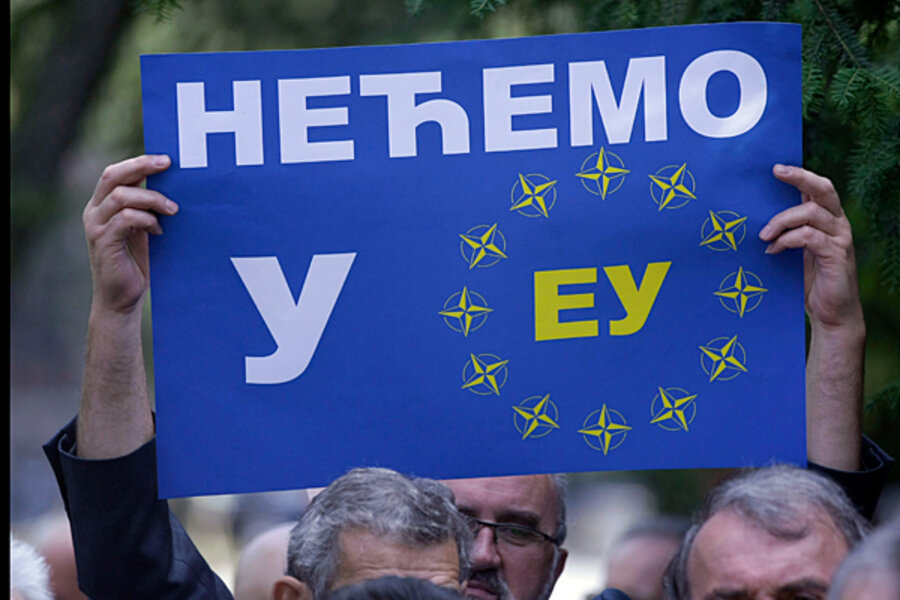European Union: Kosovo stands between Serbia and EU membership
Loading...
| Sofia, Bulgaria
Serbia must re-engage with the Kosovo government it regards as illegal in order to move closer to European Union membership, the European Commission (EC) stated on Tuesday.
In its annual report on the country’s progress, the commission recommended that Serbia should become a formal candidate for EU accession, with the caveat that the diplomatic deadlock over Kosovo must be broken. The EC cautiously praised Serbia’s development in other areas, as well as the arrest and extradition of indicted war criminal Ratko Mladic, long seen as the most important precondition to the launch of membership talks.
The Council of Ministers, the EU’s main decisionmaking body, is expected to approve candidate status in December, but when negotiations will actually start, and how swiftly they will move forward, is another question.
While the suspension of talks between Belgrade and Pristina, the Kosovan capital, is likely to prove temporary, the fundamental issue of sovereignty remains unresolved, and will be a major impediment to Serbia’s accession process unless a lasting solution is found. With other reforms also pressing, progress toward membership will be a long, slow grind at best.
Kosovo declared independence under a predominantly ethnic Albanian leadership in 2008, but Serbia considers the region a breakaway state. Belgrade runs so-called “parallel structures” in parts of Kosovo inhabited by Serbs, including municipal governments and courts. Much of the north of the region is effectively still ruled by Serbia.
But while several EU members also refuse to recognize the statelet, the EU as an institution supports independence and provides logistical support to the Pristina government.
Relations between Serbia and Kosovo have deteriorated sharply in recent months, and talks were called off in September after a farcical customs dispute and clashes on the disputed border, during which NATO peacekeepers opened fire on Serb protesters.
Serbian President Boris Tadic has stuck to his policy of heralding his government’s success in moving Serbia towards the EU while retaining a “red line” over Kosovo. Welcoming the EC’s decision, Mr. Tadic noted that there could be a “political solution” to the crisis, but stated that “Serbia has certain principles regarding territorial integrity it is not going to give up on,” according to Serbian news service B92.
With an election next year, Tadic can ill afford to either let membership status slip through his hands or risk unpopularity by making substantial concessions in Kosovo. He can probably restart negotiations without losing face, but drawing down Serbia’s Kosovan institutions would be more difficult.
“This is encouraging Serbia to keep on the European track,” says Bratislav Grubacic, a Belgrade-based journalist and analyst. “But after a couple of days of satisfaction people will start to think about Northern Kosovo. If the Serbian government wants to get closer to the EU, it will have to give something up in Kosovo. I’m not sure the current authorities are ready to give up parallel structures.”
In recent months, senior Serbian politicians and some of their Kosovar and international counterparts have suggested the “solution” of partition, with Serbia taking the north, but the EU and US have ruled this out. For the Serbs and the region that many regard as their sacred heartland, it is likely to be a long goodbye.
Even without thorny territorial problems, the road to EU accession is a long one. The EC report highlights the need to reinvigorate administrative, judicial, and economic reform, root out corruption and implement laws protecting minorities – already a lengthy wish list.
Given these issues, and the EU’s current travails, Tadic’s best-case scenario of accession by 2016 is generally seen as wildly optimistic. It is likely to be more like 2020, if not later. During this time, Serbs’ patience with the EU’s demands is likely further to be tested.
“Currently only 46-48 percent support joining the EU, with around 38 percent against, and now the more complicated part has just started,” Grubacic says.
Optimists will hope the example of Turkey is not an informative one. Until fairly recently, the country was seen to be making slow progress toward its birthright membership of the EU, even as Turkish support for the idea waned. Tuesday’s report on Turkey’s accession process, which is essentially dead, passed by almost unnoticed.





